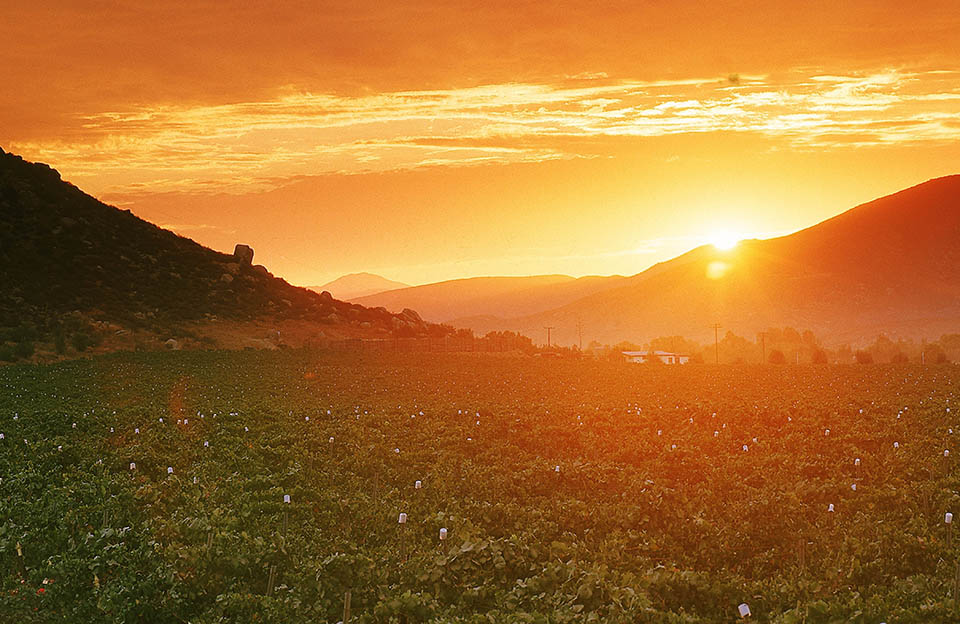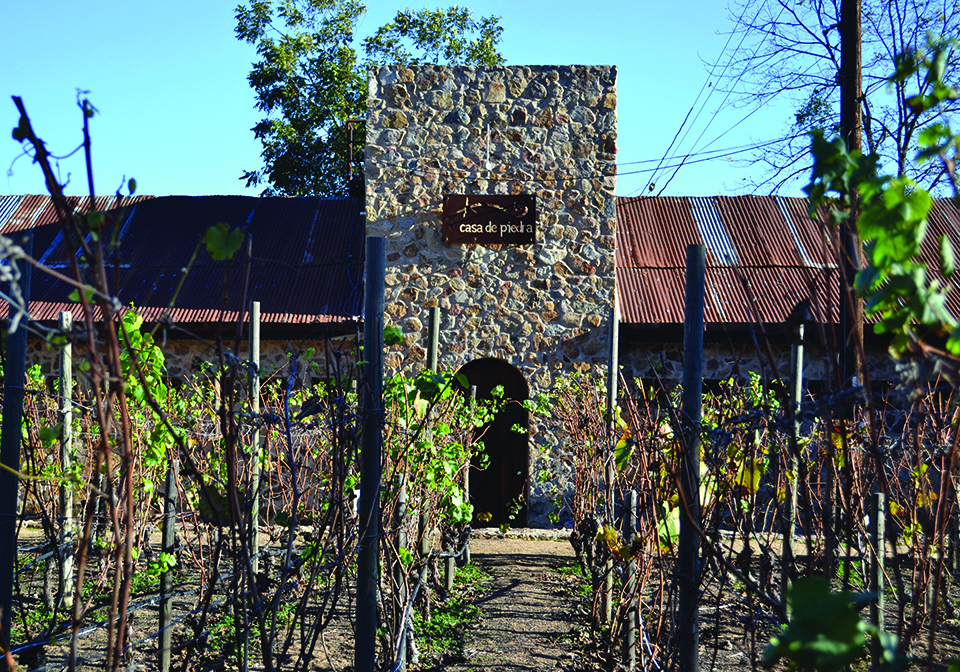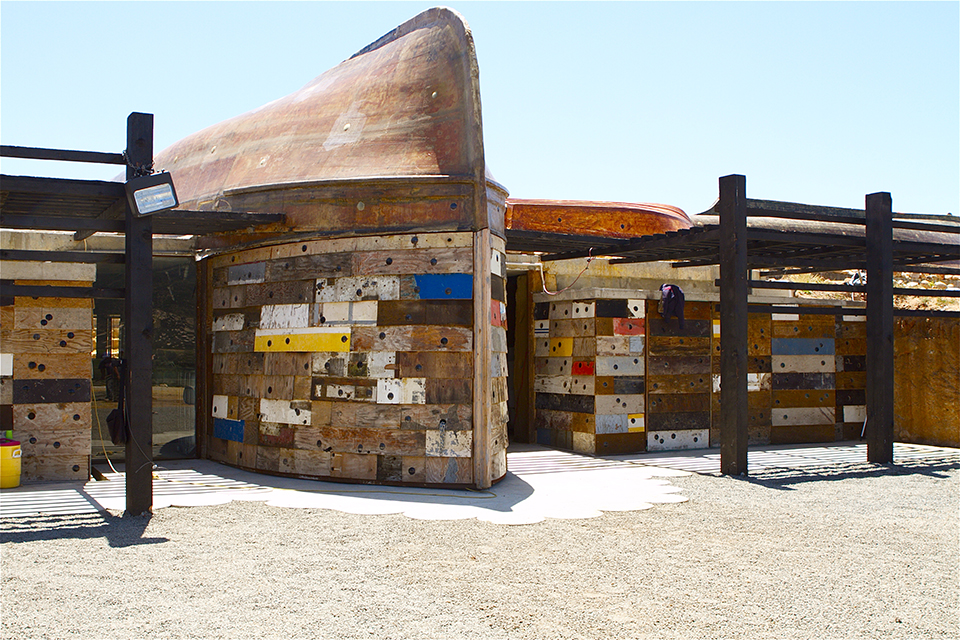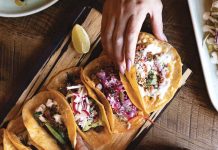
When renowned Mexican winemaker Hugo D’Acosta realized that his half of his vineyards in Mexico’s Guadalupe Valley were planted in sand and the other half in clay, he took the opportunity to demonstrate the impact of soil on wine. In 2005, the vintner—who studied in the Languedoc region of France—launched a project called Ensamble: two red blends made up of the same five varietals, each with the same percentages and identical vintages; the only difference is the origin of the grapes.
“Maturity works quite different at the vineyards in the flat part [of the valley] with sand,” explains Swiss enologist Thomas Egli, who helps manage Hugo’s portfolio. “There’s better drainage with worse water retention. They work faster. Harvest is earlier. The wines are a little more fruit-forward, a little more intense, whereas the hillside [wines have] … less intensity [and] more complexity in the aromas.”
Produced at Paralelo winery, Ensamble Arenal (from the sand) and Ensamble Colina (from the clay) offer a literal taste of the mosaic-like terroir of this rapidly expanding wine region just northeast of Ensenada. Benefiting from a Mediterranean climate bolstered by the maritime influence of the nearby Pacific Ocean, the Guadalupe Valley has experienced exponential growth in recent years and now boasts an estimated 100-plus wineries—compared to about five just 30 years ago—that produce approximately 90 percent of the country’s wine.
And with no appellation system, there are no rules; there’s nothing stopping winemakers like Hugo from cultivating the type of creativity epitomized in Ensamble. Take a trip down south to the “Ruta del Vino” (wine route) that runs through the dusty landscape producing the largest untapped variety of world-class vino—in the Guadalupe Valley, you’ll find that nonconformity is the norm.
Burgeoning Creativity

Upon entering the valley from Ensenada, the first town passed through is San Antonio de las Minas, where dusty roads are lined with colorful restaurants and street vendors selling their wares to passersby. Hugo founded his first winery, Casa de Piedra, in town in 1997; the stoic stone building designed by his brother, renowned architect Alejandro D’Acosta, was meant to be the winemaker’s home before becoming one of the region’s first premium wineries.
The “House of Stone” is surrounded by 5 acres of chardonnay vineyards, and the white varietal is one of two signature styles that make up approximately 3,300 cases produced annually. It is also the production site for a project called Contraste, in which Hugo collaborates with other wineries in the U.S. and abroad—such as Wente Vineyards in California, and his own La Borde Vieille in France—to create a 50-50 blend.
“Whereas Burgundy [in France] is famous for its pinot noir and Argentina for its malbec and New Zealand for its sauvignon blanc, … you can’t say what we are famous for,” Thomas says of the valley. “Ask any winemaker or wine producer and you get different answers. Yes, there are regions [that] produce one varietal, and we are more working with blends. Blend is the rule and one varietal more like the exception. And as far as blends, any blend. It’s like an anarchy. We are a total anarchy here.”
Some winemakers attribute the amalgamation to the fact that the valley is still young, still defining itself; others point to the absence of a regulation system that has led to a free-market mentality. In addition to a wide range of blends, Hugo is also one of the few winemakers in the valley experimenting with sparkling wine, as the seafood for which Ensenada is famous is the perfect match for bubbly. This March, he’ll open a new tasting room at Casa de Piedra, where visitors can pair his Espuma de Piedra Brut with oysters from Michelin-starred chef Drew Deckman; also not to be missed is Drew’s outdoor eatery, Deckman’s en el Mogor, just up the road.
Mobilizing the Mosaic

Continue driving north to the small town of El Porvenir, and you’ll find a group of buildings adorned in recycled decor—old irrigation hoses, wine barrel staves, empty wine bottles and vineyard poles covering walls and fences. This formerly abandoned olive oil factory is another project designed by Alejandro in Hugo’s horizontally expanding collection: Known as Estacion de Oficios el Porvenir, it serves as both production facility and school.
The main warehouse becomes a buzzing hub in August when nearly 20 local producers arrive to vinify their yields in the building’s concrete tanks, joining students from the on-site “La Escuelita,” or The Little School, where Thomas’ four-week winemaking course culminates in the production of a barrel. Though the equipment is nearly archaic—metal punch-down devices and charger plates for temperature control—the operation crushes an average of 200 tons of grapes each year. With lots ranging from 225 liters to 5,000 liters, it takes grape growers and turns them into wine producers, allowing the mosaic of vintners in the valley to continue to grow.
One benefactor of the project was England-born Phil Gregory, a former Los Angeles music producer who graduated from La Escuelita before building his own boutique winery on the same property where he runs an award-winning bed-and-breakfast, La Villa del Valle, with his wife, Eileen. Also designed by Alejandro, Vena Cava is built out of reclaimed boats and features a small tasting room where visitors can try Phil’s self-described “rich Mexican wines with a gentle European touch.” Producing approximately 2,500 cases per year, his flair for the experimental is evidenced in both process—he often ages in both French and American barrels—and production; he most recently released limited quantities of an amber wine made by fermenting the skins, seeds and stems of chardonnay grapes.
“This isn’t like Bordeaux where it’s pretty much cabernet sauvignon, cabernet franc and merlot, because they know that’s what does best there,” says Phil, who is currently producing house wines for renowned Mexican chef Enrique Olvera, including his esteemed New York City eatery Cosme. “We haven’t even gotten that far yet, and we’re happy that we haven’t. … We can do whatever we want, in general, and most people do.”
Pushing Boundaries

While boutique and artisanal producers make up the majority of wineries in the valley, there are a few commercial players creating more than 100,000 cases each year; the region’s largest producer, L.A. Cetto, makes approximately 1 million cases annually. Rising in the ranks is Monte Xanic, a family-owned winery with deep-seated roots in the valley that has been heralded as standard-setter for quality in Mexican wine.
Founding partner, technical director and enologist Dr. Hans Backhoff Escudero, who also has a doctorate in food science, established the winery in the town of Francisco Zarco with four friends in 1988. He was one of the first in the valley to plant new varietals like merlot, cabernet franc and petit verdot, and utilize techniques like French barrel aging, cold fermentation and membrane presses instead of screw presses to produce higher quality wine. “We came to change everything here,” he says, and he continues that mission today. In 2010, the winery’s Bordeaux blend, Gran Ricardo, earned 90 points from Wine Enthusiast, and a $3 million renovation resulted in a new tasting room and state-of-the-art laboratory in August 2014. Monte Xanic is currently producing about 60,000 cases annually, but the goal is 80,000 in the coming years.
“Our partners [had] this great vision of producing the best wine in Mexico,” says Hans Backhoff Guerrero, Escudero’s son and Monte Xanic CEO. “They knew they could do it here, they knew they could change Mexico. But now it’s much bigger than that, and it’s to change the world, and to some extent, to understand that Mexico produces wine.”
Monte Xanic produces four lines at different price points, simultaneously educating the Mexican market while also expanding its influence outside the country’s borders. Guerrero says he is currently exporting 2.5 percent but working to increase to 10 percent in the next three years through states like California, Texas and New York.
Until then, oenophiles will have to make their way down to Baja to experience the enology first-hand—drive the rutted dirt roads until they come to the vineyard block marked “Kristel” at the entrance of Monte Xanic. Named after Escudero’s daughter, it is the oldest on the property at 40 years old. To sip the sauvignon blanc made with grapes from the vine is to drink a small piece of the region’s history; though at less than a half-century old, it’s an indication of how young the Guadalupe Valley truly is. But maybe that’s the allure, the fact that the region is youthfully undiscovered. Perhaps the obscurity, the diversity—the risk taking—is all part of its charm.
—Written by Kristin Scharkey




